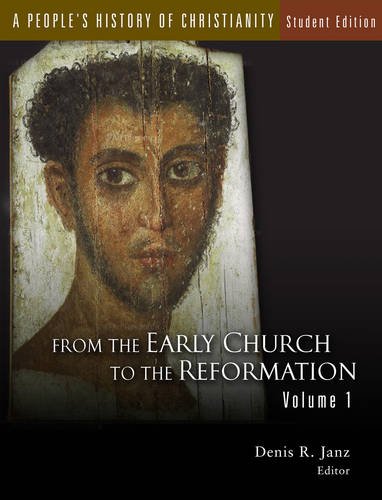Review: Denis Janz’s A People’s History of Christianity
“In this sense, people’s history is slanted, biased, disrespectful—even subversive perhaps” (8).
A People’s History of Christianity is one of the newest academic series from Fortress Press. It has been condensed from its multi-volume format to produce two Student Editions for academic use. This review will cover Volume One of the two-volume edition which covers materials from the early church to the Reformation.
Through the work of fourteen authors, A People’s History of Christianity, Volume 1 (henceforth A People’s History) seeks to present a new look at the development of the church focusing on the people who make up the church. The result is a history of the real lives of ordinary church people.
The Communication
At its core, A People’s History is a uniformed effort to reconsider varying church related topics. Editor, Denis Janz, performed a tremendous job bringing together highlight chapters from the original seven volume series. Though these chapters do not flow into one another or build off each other, the content is fresh and captivating. The stand-alone nature of the chapters in it makes it a wonderful resource to both read straight through or topically according to interest. This makes it an excellent academic resource, for which it was intended, or as a volume of personal study. On the whole, A People’s History presents its information in a resoundingly helpful manner, suitable for everyone interested in church history.
Each of the authors of A People’s History communicates their topic clearly and provides the markers of the distinct perspective that can develop from evaluating the people of Christianity. For evangelicals, it represents a less conservative approach to the Scripture and church tradition. In many cases the challenging insight is a welcomed breath of fresh air.
The Content
The chapters in A People’s History are laid out in a survey of church history up to the Reformation. Starting with an intense focus on the early church (chapters 1-3), the book moves through an evaluation of Roman society, the Byzantium church, and the medieval period. It is in these early chapters that the more liberal scholarship of the authors stands out. Despite its conflict with conservative ideals the effort is predominantly beneficial. For instance, William Herzog II presents an outstanding paradigm of agrarian and village culture for studying the parables of Jesus Christ (79-90). One of the book’s highlights is the chapter’s presentation of new perspectives on the parables of Lazarus (Luke 16:19-31) and the rich landowner (Matt 20:1-16).
Chapters 5 and 6 provide outstanding insight on the impact that martyrdom and food, respectively, had in the development of the church. Widespread in their application throughout the church, these chapters show the dramatic passion of the martyrs alongside the simple practice of sharing a meal. Today’s church can still learn from the early church the importance of “the simplest meal to become a vehicle for power and forms of divine presence” (156).
The highlights of A People’s History are the chapters concerning the Byzantium area and period. Chapter eight, on the preaching of John Chrysostom, is both widespread enough to provoke practical discussion and particular enough to give a profound level of historical insight. The emphasis of Chrysostom’s preaching on “Christian habit” (196-197) and other practical concerns are stories of application for the modern church and its pastors. Similarly, the desire of ordinary people to be religious is capably captured in chapter ten. These chapters are wrapped within a focus on the practice of the Byzantium church (chapter seven) and the general practices of shrines and festivals (chapter nine) to provide a great example of Eastern Church practice and life.
The only complaint against A People’s History is its focus on specific regions of the church. This is a natural consequence of a condensing the multi-volume original series. But notably neglected are the Oriental church with its deep Coptic history and the less prominent practices of the church in Africa. In light of this, chapter 4 (on the focus of history) seems only to repeat information previously presented in earlier chapters. Similarly, chapter 12 on church architecture provides many interesting stories but fails to present a full “people’s history.” Since the chapter is focused primarily on church structures in England (303), it falls short of the standard set by other chapters. Though other chapters specialize in particular regions (chapters 7-10 for instance), this final chapter by Richard Kieckhefer seems too broad a subject to reduce to such a small region.
Conclusion
A People’s History is a joy to read and provides valuable information in a condensed form. For those less inclined to academic study, the new angle of this book is at times rough around the edges and jarring in its conclusions. However, it consistently provides insights to the biblical texts, as well as the development of church doctrine, practice and architecture. A People’s History may present some “biased, disrespectful—even subversive” (8) content but is valuable to conservative laymen and pastors seeking a new perspective on the many topics covered. The book, therefore, is to be recommended for an alternative look at church history.
Disclosure of Material Connection: I received this book free from the publisher. I was not required to write a positive review. The opinions I have expressed are my own. I am disclosing this in accordance with the Federal Trade Commission’s 16 CFR, Part 255: “Guides Concerning the Use of Endorsements and Testimonials in Advertising.”

Joshua Torrey is a New Mexico boy in an Austin, TX world. He is husband to Alaina and father to Kenzie & Judah and spends his free time studying for the edification of his household. These studies include the intricacies of hockey, football, curling, beer, and theology. You can follow him @AustinPreterism and read his theological musings and running commentary of the Scriptures at The Torrey Gazette.
